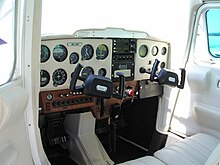Yoke (aeronautics)





A yoke, alternatively known as a control wheel is a device used for piloting some fixed-wing aircraft.[1]
The pilot uses the yoke to control the attitude of the plane, usually in both pitch and roll. Rotating the control wheel controls the ailerons and the roll axis. Fore and aft movement of the control column controls the elevator and the pitch axis.[1] When the yoke is pulled back the nose of the aircraft rises. When the yoke is pushed forward the nose is lowered. When the yoke is turned left the plane rolls to the left and when it is turned to the right the plane rolls to the right.
Small to medium-size aircraft, usually limited to propeller driven, feature a mechanical system whereby the yoke is connected directly to the control surfaces with cables and rods. Human muscle power alone is not enough for larger and more powerful aircraft, so hydraulic systems are used, in which yoke movements control hydraulic valves and actuators. In more modern aircraft, inputs may first be sent to a fly-by-wire system, which then sends a corresponding signal to actuators attached to the control surfaces. Yokes may feature a stick shaker, which is designed to help indicate the onset of stall, or even a stick pusher, which assists in stall recovery. [citation needed]
Styles
Yokes come in a variety of shapes and sizes, the most common being of a "U" or "W" design. Some aircraft use an "M" style, such as Embraer and Concorde. There are some rarer exotic or archaic styles, such as circular designs much like a steering wheel.
In larger aircraft they are usually mounted on a post protruding vertically from the floor, referred to as a control column. In most other planes, they are mounted on a horizontal tube that comes out of the instrument panel.
Advantages and disadvantages
Side-sticks and centre-sticks are better for making rapid control inputs and dealing with high g-forces, hence their use in military, sport, and aerobatic aircraft. However, yokes are less sensitive (i.e., more precise) thanks to a larger range of motion and provide more visual feedback to the pilot.[2]
Most yokes are connected and will both move together, thus providing instant indication to the other pilot when one makes a control input. This is in contrast to some fly-by-wire control sticks that allow each pilot to send different, and sometimes greatly conflicting, inputs such as was experienced on Air France Flight 447,[3][4] the Airbus A330 Rio-Paris flight that crashed into the sea in 2009.
Yokes take up more room than side-sticks in the cockpit, and may even obscure some instruments; by comparison, side-sticks have minimal cockpit intrusion, allowing for the inclusion of retractable tray-tables[5][6] and making it easier to enter/leave small cockpits.
A yoke, unlike a side-stick, may be used comfortably with either hand. This can be useful if one needs to write or manipulate other controls in the cockpit. This advantage is shared with the centre-stick.[2]
Ancillary functions
The yoke often incorporates other key functions such as housing thumb or finger buttons to enable the radio microphone, disengage the autopilot, and trim the aircraft. In addition, there may be a clipboard, checklist, or chronometer located in the yoke's centre.[7][8][9][10]
Alternative control systems
Yokes are not used on all aircraft. Helicopters use a cyclic[11] and the majority of military fighter aircraft use a centre or side-stick. Some light aircraft use a stick because some sport pilots prefer that control system. The latest Airbus family of passenger jets use a side-stick, not unlike a computer game controller, to actuate control surfaces.[12][13]
There are also computer input devices designed to simulate a yoke, intended for flight simulators.
See also
- Aircraft flight control system
- HOTAS, Hands On Throttle-And-Stick
- Joystick, computer input device
References
- ^ a b Crane, Dale: Dictionary of Aeronautical Terms, third edition, page 563. Aviation Supplies & Academics, 1997. ISBN 1-56027-287-2
- ^ a b Mc Clellan, J. Mac (May 2008). "New Gulfstream, p. 52". Flying Magazine. 135 (5): 52–57. Retrieved July 7, 2012.
... sidesticks don't provide visual feedback and actually don't move much at all as they respond to the pressure applied by the human pilot ... in the G650 when you grab the yoke and move it, the one on the other side will respond just as it does on a conventional airplane.
- ^ "Is Flight 447's 'Fly-by-Wire' Aircraft Technology Safe?". Fox News. 2009-06-12. Retrieved 2013-05-29.
- ^ Ross, Nick (2012-04-28), "Air France Flight 447: 'Damn it, we're going to crash'", The Daily Telegraph (article),
It seems surprising that Airbus has conceived a system preventing one pilot from easily assessing the actions of the colleague beside him. And yet that is how their latest generations of aircraft are designed. The reason is that, for the vast majority of the time, side sticks are superb.
- ^ "Learning To Fly In A Cirrus SR22". planeandpilotmag.com
- ^ "Gear Up: One Big Airplane Training in US Airways' newest A330 simulator". flyingmag.com
- ^ Picture of the Canadair CL-600-2B19 Regional Jet CRJ-200ER aircraft
- ^ Picture of the Lockheed C-130H Hercules (L-382) aircraft
- ^ Picture of the McDonnell Douglas DC-9-32 aircraft
- ^ Picture of the Beech 58 Baron aircraft
- ^ How Helicopters Work
- ^ "Fly-by-wire - A CIVIL AVIATION FIRST". Airbus / Innovation / Proven concepts / In design / Fly-by-wire. Airbus. Retrieved 6 July 2012.
- ^ Flying the Airbus side stick - the one with the fastest thumb wins!
